How to choose the best racing kayak or surfski

Looking for the ideal kayak or surfski to race in but not sure where to start? There are many options to be considered and that is exactly what we hope this guide will help you navigate. Follow these eight steps to help you identify the best racing kayak or surfski for you.
Step 1 – Identify where you can paddle
Most kayaks and surfskis are specifically designed for a particular racing discipline and a specific water type in mind. Lake, river, white-water rivers, estuary, bay or ocean all have their own challenges which influence the design of kayaks and skis and the racing which you can participate in. The flatter more placid the water such as lakes and rivers will allow you to choose from a greater range of kayaks for your racing with craft like ocean skis also able to handle these conditions but not the other way around. It may also be the case that you will need to look into owning multiple kayaks if you are looking to be competitive in two or more disciplines with different water environments.
Step 2 - What type of paddle racing do you want to do?
Are you seeking to get healthy and fit in the kayak or do you want to race for medals? If it’s medals at club, state or national level you have aspirations of you may need to consider the racing specifications on the type of paddling. The International Canoe Federation (ICF) specifies the rule which govern canoe racing designs and are covered in more detail at the bottom of this guide.
Assessing what type of paddling you want to do and your paddling goals will influence the stability of the kayak you will choose. If you are not sure of the type of paddling that you want to do or have access to, we suggest that you get in touch with your nearest canoe club or retailer and consult them for more advice.
Step 3 - Storage and Transport
Access to water types for different kinds of paddling is a big factor and should be considered with the addition of storage and transport. Storage of a kayaks and surfskis is not easy due to their size. If you don’t have a canoe club or surf lifesaving club with available rack space, you will most likely need to store it in your own garage if it is big enough.
If you are lucky enough to have space to store your kayak or surfski at home, you will need an appropriate vehicle and roof rack system to transport it to the water. If you are unsure on where to start when transporting your kayaks and surfskis read our guide on what to consider here. In addition to these considerations, the weight of the kayak or surfski to lift it onto the roof can be a factor for some paddlers as well so a lighter kayak may be required for this.
Step 4 – Balance before you buy
Knowing the type of water and storage you have access to as well as the paddling type that you want to do will considerably narrow your options. However, access is still a big influence in choosing the right racing kayaks and surfskis. With each paddlers skills and balance abilities being different there is a real need to try before you buy.
Access to clubs with a variety of brands and models of kayaks to try before buying is ideal. Otherwise, you will be limited by your local retailers and the brands which they supply to your local area. Wash Rider is lucky enough to be supported by a number of shops who have kayaks and surfskis available to test which you can find here.
Step 5 – Stability, Comfort and Size
These three factors influence how a kayak or surfski performs, how it fits you and your enjoyment:
Step 6 - Performance test
Placing the manufacturers marketing aside, testing your potential kayaks and surfskis objectively is the only way to objectively compare their performance. This means paddling your short list of craft on the same test course.
We recommend the 3 x 3 test as the ideal way to compare the performance of your top 3 (craft A, B and C) potential new kayaks or surfskis. On a consistent section of water, setup a 1000m course specific to the type of paddling you want to do. Then test each craft 3 times in the same order (i.e. test A,B,C, A,B,C, A,B,C) and time them. Make notes each time on performance factors that matter to you such as comfort, turning ability, acceleration off the line etc.
An example of this may be a marathon paddler testing 3x K1 kayaks down a 500m course, then turning around a 3 buoy turn and returning 500m with a portage in the return. This is specific and test, straight line speed, turning ability and race specific elements with the portage.
Step 7 – What is your budget?
It’s important to work out how much you want to spend on your kayak or ski and any accessories or additional fittings that you may need. Specialist racing craft can typically start around AUD$3800+ with many costing far more. Plastic or basic fibreglass constructions can start much cheaper but it is crucial to consider that you get what you pay for. More expensive and lighter carbon fibre layups with foam core will have higher performance properties through their stiffness and reduced weights but will cost far more. Remember here that the lighter the kayak or surfski the faster it will accelerate with less effort.
Second hand purchasing is very popular with such as high turn over of craft as people progress through the stability levels and on sell their old more stable craft. If you are considering a pre-loved kayak or surfski we recommend reading our blog to learn what to avoid with the six signs your surfski or kayak is not healthy.
Step 8 - What equipment and accessories do you want to fit?
Once you’ve determined the right kayak or surfski for you, it’s then time to consider the equipment and/or accessories to upgrade it with. Often a kayak is sold only with the basic fittings and nothing more. It’s up to you to decide on what you want to add to the craft to make it more comfortable or specific to your racing style. This will in part be determined by the compatible fittings that are on offer. Some common additions include:
- Pedals or tiller bars steering options
- Foot Pumps for marathon paddlers
- Portage handles
- Combinations of foot straps and pull bars on your footplate
- Rudder cable tensioners rather than cable ties
- Seat padding
- Footplate traction pads
- Chine protection
- Weight systems to make ICF rules or training with a heavier kayak
- Watch holders
- Different rudder sizes/types
- Weed deflectors
Types of kayaks and skis
Now to take a look at the different types of kayak and surfskis on the market and sort of paddle racing they allow for.
Kids Kayaks & Skis
This is probably the most important category of kayak as it teaches the next generation to have fun and learn the balance and skills of paddling. Kids kayaks and surfskis are very limited in design styles and sizes. The most important factor to consider when looking for a child is the leg length range. You want the greatest amount of leg length to get the most time out of the kayak while the child is growing. And remember too, the aim of getting a kid’s kayak is for them to have fun and enjoy learning the sport properly. A heavily modified adult size craft may not be the best option.
Sprint Kayaks
Designed for use on flat and placid waters only K1 sprint kayaks are the fastest kayaks on the market. They are not designed for recreation but are focused on competition speed which comes at the expense of stability. This kayak is best paddled on lakes, rivers and estuaries where the surface of the water is often reflecting light like a mirror.
Restricted to 12kg for ICF competitions over distances of 200m, 500m, 1000m and 5km these kayaks come in single K1, 2 person K2 and 4 person K4’s. The Olympic sprint format means that they have evolved to go really fast in a straight line.
Marathon Kayaks
Seeking the speed of a sprint K1 but greater performance when wash riding, and turning in races the marathon kayak scene is evolving. Originally these kayaks were typically a lighter weight sprint K1 to meet the ICF rules 8kg minimum. However, in the recent decade manufactures have become more specialised in this category of kayak and are progressing designs that perform better in turns, wash riding and maintaining a high speed for longer to respond to the changes in racing format of marathon kayaking. One example of this is the latest hard edged hull by Roman Kayaks.
Rising popularity of pedals over traditional sprint tiller bars is also occurring in parallel with the rising popularity of ocean skis. Due to the nature of racing in packs and on the modern lap format the need for a footplate fitted with a foot pump is essential to remove water from the inside of the kayak during these longer races. Comfort is king for the longer race format too, with seats and footplates essential to allow your mobility for performance throughout a marathon race in these skinny kayaks.
River Kayaks
River racing kayaks combine a trailing rudder and different construction materials with the speed of a marathon K1 kayak. These rudders allow for the kayaks to be raced down white-water rivers, over rocks and other obstacles without losing your steering. The different materials and resins used in the construction layup of the river K1s provides more flexibility in the hulls to allow them to graze off rocks and logs without cracking like the stiff carbon hulls of sprint K1s. This is usually referred to as a ‘river layup’ with no foam core and fibreglass or Kevlar cloth combined with a flexible resin in the construction.
These K1s are popular choice as they are generally more stable through their width and lower seats thank other K1s, are cheaper due to the material types, quality of the fittings and higher weight. They commonly come standard with pedals due to the high frequency and high angle of turning required in river racing to correct course during rapids and weaving through trees. Foot pumps in combination with spraydecks are also essential for this style or racing with the rapids and pack racing throwing large amounts of water into your kayak. These kayaks are best used in marathon kayaking and river racing.
Down River Kayaks (DR)
Raced in 2- 20min courses these kayaks ride waves and rapids superbly well and superbly fast downstream. Typically, not installed with any rudder or steering mechanism these DR kayaks require the paddler to hip steer the kayak down the river. This is when one hip is pushed down and the other hip up to change the hull shape and therefore direction of the kayak.
Governed by ICF rules which determine the minimum width the DR class has maintained the large bulbous shape in the rear while the hull has become narrower and faster. Very specific to river racing these kayaks are common in areas which have access to the right type of white-water. These kayaks are usually in a river layup to deal with hitting rocks and logs and use knee braces to hold you in while doing eskimo rolls. They are obscenely fun to ride the white-water rapids in and we highly recommend giving them a go if you ever have the opportunity.
Ocean skis
Arguably the most popular category with more choice and stability levels than any other category of kayaks or surfskis. While choice is a good thing, it can be over whelming. If you are set on wanting a generalist racer with the versatility of paddling fast on both flatwater and ocean then this is a great place to progress.
Choosing an ocean ski will come down to the comfort of the seat bucket. Many paddlers will say they have a butt shaped for a particular brand of ocean ski which prevents them from paddling others. This isn’t always a brand loyalty thing; rather it is a comfort limitation of the seat ergonomics being slightly different between each manufacturer.
The entry from a jetty pr pontoon can be difficult with any ocean ski or spec ski so consider your local water ways although they are much easier to re-enter if you fall off them than sprint K1 kayaks. The range of ocean skis means that you can progress quickly up through the stability levels on offer and be competitive quickly with even the fastest kayaks in most club races.
Surf Life Saving Surf ski or Spec Ski
These craft are made specifically for breaking in and out of the surf zone on beaches where the waves are crashing in. Weighing in at a solid 18kg minimum specification surf lifesaving (spec) surfskis are engineered to take repetitive force to endure the crashing force of a wave breaking on top of them often and still go fast.
This style of racing is fairly limited to a few countries who participate in surf lifesaving competitions. To watch out for when buying these surfskis is that many of the older models on the market have a fixed leg length so you will need to be sure of your fit before you buy.
Multisport kayaks
Extremely popular in Europe and New Zealand the multisport kayaks are made for coping with a range of water types and going fast. The front deck will generally be high like a down river racer to allow this volume to punch through rapids and displace the water to the sides rather than hitting you in the cockpit. These kayaks aren’t governed by the ICF rules so there is a large variety of lengths, widths and shapes to choose from while still getting some impressive speeds.
Sea kayaks
The sea kayak category is a tough one to describe as it covers all types of designs layups and a large number of use cases. These kayaks are typically designed for bay or open ocean paddling while transporting camping gear and food for extended kayak trips.
Many sea kayaks offer great stability compared to ocean skis or racing kayaks but there are exceptions with some designed more like multisport kayaks and able to maintain some healthy speeds for racing in. If you are seeking to use a sea kayak for racing, we highly recommend one with a rudder (either under stern or over stern trailing rudder) as opposed to a skeg or rudderless design.
We hope this information gives you a useful guide, overall understanding of the different types of racing kayaks – paddling options – out there. We always recommend heading to your local club and retail shops to start a conversation with them. They are a wealth of knowledge and will be able to help you as you progress in your paddling.
- Kieran Babich









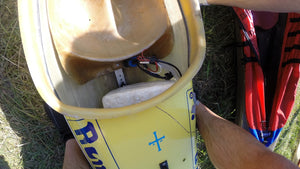
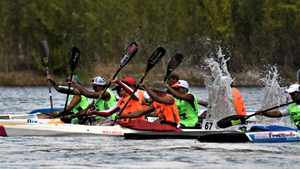
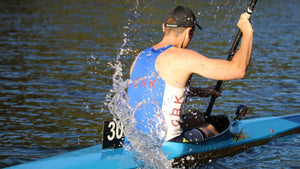
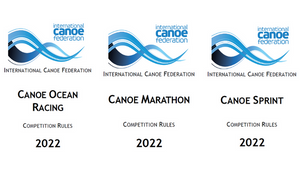
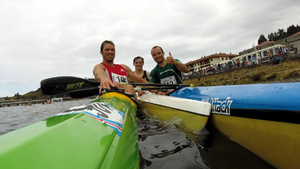
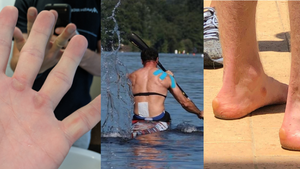
Comments 0